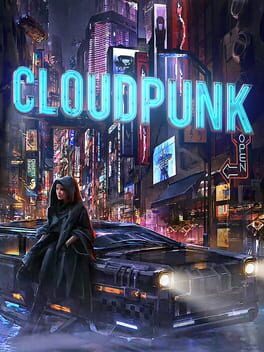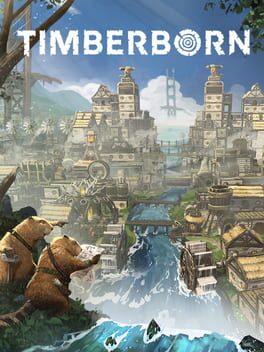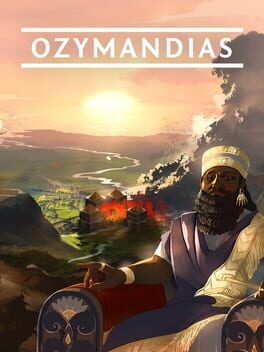Glinko_Dool
2020
Cloudpunk is more an immersive mood piece than it is as a compelling video game. The sparse gameplay elements are more an afterthought, tacked onto a stylistically competent if cliche cyberpunk dystopia. To me it makes the creators seem almost desperate, more proud of the world they've rendered than eager for me to play their actually viable interactive game. The third person camera is pulled way back - so far that it is sometimes hard to discern the player character from the blocky denizens of this trite metropolis. They're practically begging you to take your hand off the keyboard to step back and marvel at the volume of voxels displayed.
But is the world truly that interesting? It's a one note cyberpunk megalopolis, where even though individual apartment blocks are visually distinct, they lack an emotional distinction. What remains is a muddy pastiche of obvious influences without a coherent design statement of its own. I searched for something to attach to here, but was left floating on the breeze.
I don't doubt that some will love the atmospheric driving, revel in the tales told on the radio, and fall into a complacent enjoyment of Cloudpunk's meager interactivity. Certainly this looked compelling enough for me to try it. But just like the city itself, looks can be deceiving. With a little more edge, a little more focus, and a lot more player input, perhaps Cloudpunk could have risen beyond it's mood board aspirations.
But is the world truly that interesting? It's a one note cyberpunk megalopolis, where even though individual apartment blocks are visually distinct, they lack an emotional distinction. What remains is a muddy pastiche of obvious influences without a coherent design statement of its own. I searched for something to attach to here, but was left floating on the breeze.
I don't doubt that some will love the atmospheric driving, revel in the tales told on the radio, and fall into a complacent enjoyment of Cloudpunk's meager interactivity. Certainly this looked compelling enough for me to try it. But just like the city itself, looks can be deceiving. With a little more edge, a little more focus, and a lot more player input, perhaps Cloudpunk could have risen beyond it's mood board aspirations.
2014
Yes, it is cool that the Serious Sam devs created a contemplative philosophical puzzle game. No that does not mean that The Talos Principle is some genre defining proclamation of metaphysical heft. What it is, most certainly, is a nifty puzzle sandbox that just slightly wears out its welcome, with a spottily compelling deific narrative clumsily shoved in the open cracks.
The design fundamentals are solid. There are player-controlled objects that create and react to the level in specific ways, and levels with varying obstacles for you to apply these objects to. Some are thought-provoking brainteasers where the player has to concoct a specific sequence of events to complete. Others, however, are little more than technical rube goldbergs, placing laser refractors in just the right way as to be tedious rather than enlightening. The frustration of not knowing which kind of level you are going to get stays in the forefront of the player's mind throughout The Talos Principle - and is why the lore terminals dotted around the ancient landscapes should provide a welcome respite.
But the framework for why you are doing these puzzles is eye-rollingly cliche. During the first 15 minute tutorial it’s quite obvious what is happening, and the mystery of the world falls away. The music queues and almost Myst-like design of the ethereal puzzle gardens do provide some desperate ambience, but computer terminal after computer terminal confirming your prior assumptions does little to ameliorate the fact that there should be something more going on beyond the simple narrative chassis. Admittingly, a few of the terminal entries and dialogue options are compelling and thoughtful, and are well written enough to exceed most AA video game writing.
Despite all of this, I like a lot of what’s presented here, even if it's a tad overstuffed. The gameplay mechanics are solid, if uninspired, and lead me to a satisfying amount of “aha” moments. The story is… fine, but isn’t creatively interesting enough to hang the rest of the game on. By the time I was able to climb the final tower and truly complete the game, I was wholly ready to leave the garden.
The design fundamentals are solid. There are player-controlled objects that create and react to the level in specific ways, and levels with varying obstacles for you to apply these objects to. Some are thought-provoking brainteasers where the player has to concoct a specific sequence of events to complete. Others, however, are little more than technical rube goldbergs, placing laser refractors in just the right way as to be tedious rather than enlightening. The frustration of not knowing which kind of level you are going to get stays in the forefront of the player's mind throughout The Talos Principle - and is why the lore terminals dotted around the ancient landscapes should provide a welcome respite.
But the framework for why you are doing these puzzles is eye-rollingly cliche. During the first 15 minute tutorial it’s quite obvious what is happening, and the mystery of the world falls away. The music queues and almost Myst-like design of the ethereal puzzle gardens do provide some desperate ambience, but computer terminal after computer terminal confirming your prior assumptions does little to ameliorate the fact that there should be something more going on beyond the simple narrative chassis. Admittingly, a few of the terminal entries and dialogue options are compelling and thoughtful, and are well written enough to exceed most AA video game writing.
Despite all of this, I like a lot of what’s presented here, even if it's a tad overstuffed. The gameplay mechanics are solid, if uninspired, and lead me to a satisfying amount of “aha” moments. The story is… fine, but isn’t creatively interesting enough to hang the rest of the game on. By the time I was able to climb the final tower and truly complete the game, I was wholly ready to leave the garden.
2021
2022
A cute little 4X that has been simplified down into easy to digest bite-size chunks. Not a lot of depth to it - but that's perfect for the 30 min sessions that the game is aiming for. Once you get an understanding of how it operates, pretty much every game is going to follow the same pattern. I have no idea why this hasn't been ported to iOS yet, it's possibly the most perfect "made for iPad" PC game I've ever seen.
2022
Railgrade is a resource management game where you can't really manage resources and a train game (real genre!) with lackluster track control options. Due to most stages being timed, moment-to-moment gameplay is less fighting against the clock and the rigors of the level, and more fighting against the core game mechanics themselves. Disappointing.
2012
It seems we have, as a society, completely lost the plot in regards to what makes a good mobile game. There was once a time, not too long ago, when respected people throughout the gaming industry were genuinely convinced that the ascendant Goliath of mobile gaming would put everyone out of business. In the decade or so since these proclamations, the furthest innovation the scene has gotten seems to be jiggling AI generated anime women beckoning you to play War of Clash: Clicker Origins.
It turns out the perfect mobile game was made over a decade ago. It's called Angry Birds. But Flow Free definitely fills out the rest of the elite roster. It's a commute game through and through - sitting down with it for more than 40 minutes would bore you to tears. But any less and you will certainly enter a flow state (sorry) that has had me seeing pipes for hours after I've put my phone down.
All you need is a simple core gameplay loop (connect dots with pipes), add twists on the formula (bridges, walls), and create harder levels (larger grid). Plus have enough stages to occupy months of transit, and you've got a extremely competent puzzle game.
It turns out the perfect mobile game was made over a decade ago. It's called Angry Birds. But Flow Free definitely fills out the rest of the elite roster. It's a commute game through and through - sitting down with it for more than 40 minutes would bore you to tears. But any less and you will certainly enter a flow state (sorry) that has had me seeing pipes for hours after I've put my phone down.
All you need is a simple core gameplay loop (connect dots with pipes), add twists on the formula (bridges, walls), and create harder levels (larger grid). Plus have enough stages to occupy months of transit, and you've got a extremely competent puzzle game.
2023
For over half a decade gamers have been asking the simple question, "Are Battle Royales actually fun?" The answer - sometimes - isn't quite the digestible response most are looking for. If you like the genre - Great! If not - there is a glut of traditional multiplayer shooters to choose from. But what if a keen developer tried to turn the "sometimes" moments from BRs into the main gameplay loop for a whole title?
Enter The Finals, A heart-pounding destruction-based, team-oriented, class-focused 3v3v3(v3) arena shooter gumbo that gasp has a high enough TTK that even the most geriatric of players can respond when an enemy gets the jump on them. It turns out that making a game that consists pretty much entirely of the highlight reel moments of most Battle Royales is pretty fun to play!
However, many of the positive developments brought forth also have extreme drawbacks. The wholesale destruction of entire maps brings calculated chaos into team strategies, but the resulting detritus makes for glitchy geometry that is more frustrating than fulfilling. The class tied unlocks allow for diverse team comps and resulting tactics, but only a month into it's lifespan meta builds and cheesy combos already dominate. Some will point to that as a natural evolution of any game like this - I'm inclined to agree! - but it doesn't make it any less unsatisfying.
And then there's the lack of variety. Yes, this is a live service game and I'm sure the devs will add more gamemodes down the line. But as of now there are truly only two ways to play. And just by looking at the sandbox we are given in those, you can tell there is a plethora of untapped potential here. I sincerely hope The Finals doesn't die on the vine, and instead matures into a more complete and polished version of what it already is.
Enter The Finals, A heart-pounding destruction-based, team-oriented, class-focused 3v3v3(v3) arena shooter gumbo that gasp has a high enough TTK that even the most geriatric of players can respond when an enemy gets the jump on them. It turns out that making a game that consists pretty much entirely of the highlight reel moments of most Battle Royales is pretty fun to play!
However, many of the positive developments brought forth also have extreme drawbacks. The wholesale destruction of entire maps brings calculated chaos into team strategies, but the resulting detritus makes for glitchy geometry that is more frustrating than fulfilling. The class tied unlocks allow for diverse team comps and resulting tactics, but only a month into it's lifespan meta builds and cheesy combos already dominate. Some will point to that as a natural evolution of any game like this - I'm inclined to agree! - but it doesn't make it any less unsatisfying.
And then there's the lack of variety. Yes, this is a live service game and I'm sure the devs will add more gamemodes down the line. But as of now there are truly only two ways to play. And just by looking at the sandbox we are given in those, you can tell there is a plethora of untapped potential here. I sincerely hope The Finals doesn't die on the vine, and instead matures into a more complete and polished version of what it already is.
2020
Too much has been said about Cyberpunk's buggy launch, it's overpromising marketing campaign, and the lack of dialogue depth and RPG mechanics. But coming back to it after 3 years and a complete overhaul of gameplay mechanics, it's hard not to love the pieces, if not the totality, of this mess.
The moment-to-moment gameplay is exceptional - blasting gangoons with a modded-out power shotgun before dashing into cover to recover RAM doesn't get old - but the quieter moments are what really stand out. Basking in the neon glow of some dirty alley in Kabuki, covered in the blood of your last gig while Coltrane comes on the radio. Reading the background of your target in the fixer's attachment while stalking some corpo stooge - and being surprised when Silverhand appears in the corner of your eye just to admonish you.
In fact, this game's greatest asset (besides the unparalleled world of Night City) is Keanu's stellar work as the resurrected rockerboy. Where the game stumbles is gluing all of this together into one cohesive whole. When the cyberpunk genre trappings hit, they hit. But too often these thought-provoking stories are marred by their marriage to gameplay. An AI cabbie experiencing multiple personality disorder? Great! Repeatedly following 7 basically identical cars at lackadaisical speed while a (god help me) audio recording plays? Boring as shit!
Often the best moments I had in Cyberpunk had nothing to do with the main quest or curated side stories. Just the ambience of being a small-time mercenary doing a gig in an intricately detailed shanty, discovering a datashard that contains delightful worldbuilding mumbo jumbo. "Of course our target was a Militech mole - he defected from the Soviets after the Fourth Corporate War!" This is when I'm locked into 2077's earnestly goofy wavelength, reveling in a totemic entry into the genre canon. But then the gig is over, I drop the key item into the drop point for the umpteenth time, and open the map to look for the next hustle to cross off my checklist. It could be a preem gig, but there's a lot of slag to sift through to find it.
The moment-to-moment gameplay is exceptional - blasting gangoons with a modded-out power shotgun before dashing into cover to recover RAM doesn't get old - but the quieter moments are what really stand out. Basking in the neon glow of some dirty alley in Kabuki, covered in the blood of your last gig while Coltrane comes on the radio. Reading the background of your target in the fixer's attachment while stalking some corpo stooge - and being surprised when Silverhand appears in the corner of your eye just to admonish you.
In fact, this game's greatest asset (besides the unparalleled world of Night City) is Keanu's stellar work as the resurrected rockerboy. Where the game stumbles is gluing all of this together into one cohesive whole. When the cyberpunk genre trappings hit, they hit. But too often these thought-provoking stories are marred by their marriage to gameplay. An AI cabbie experiencing multiple personality disorder? Great! Repeatedly following 7 basically identical cars at lackadaisical speed while a (god help me) audio recording plays? Boring as shit!
Often the best moments I had in Cyberpunk had nothing to do with the main quest or curated side stories. Just the ambience of being a small-time mercenary doing a gig in an intricately detailed shanty, discovering a datashard that contains delightful worldbuilding mumbo jumbo. "Of course our target was a Militech mole - he defected from the Soviets after the Fourth Corporate War!" This is when I'm locked into 2077's earnestly goofy wavelength, reveling in a totemic entry into the genre canon. But then the gig is over, I drop the key item into the drop point for the umpteenth time, and open the map to look for the next hustle to cross off my checklist. It could be a preem gig, but there's a lot of slag to sift through to find it.








